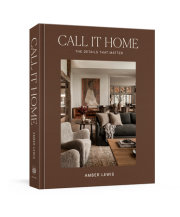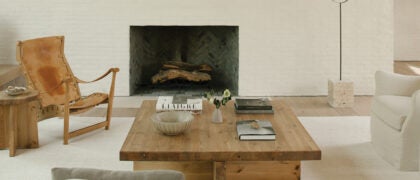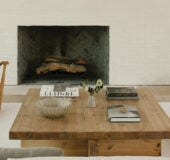How do I get your look?
As an interior designer and a lifestyle blogger, I’m asked a lot of questions, and how to translate my style is the one I get asked most. By now, "my look" has become distinct enough that I like to think if you viewed a police lineup of five different homes you’d instantly identify the one I designed. That said, you might not be able to easily sum it up in a few words. Even I struggle with that, because my look isn’t about one thing or the other but rather it’s a specific mix that I’ve spent years developing.
I don’t believe in being monogamous to one design vibe. If you’re looking for a rule book and guide to the "right" way to design a home,
Made for Living isn’t it. But if you want to develop a personal approach to interior style that feels as if it grew up out of the ground, rather than bought or prescribed—well, then, you’ve come to the right place. Get ready for spaces that feel both fresh and current but also layered and approachable, homes with finishes that are tactile and rooted in nature, and furniture that effortlessly mixes flea market finds and sleeker shapes in a blend that feels like it will last forever. My kind of elusive, laid-back California cool can be had anywhere—whether you live in a Manhattan apartment or in the middle of suburbia.
You can take the title of this book literally: Everything in these pages is really made for
living. In the rooms I design, the sofas are matched with beautiful ottomans upholstered in tactile fabrics that, yes, you can actually put your feet up on (or, in my case, Converse). In my own kitchen, I used one of my favorite materials: beautiful, variegated Moroccan glazed terra-cotta tiles. They’re full of nicks and dings; no two pieces are alike. And that’s why I love them. "Perfect" is not my goal.
Livability is my true north. I don’t want you to worry about constantly fluffing your pillows. I gravitate toward things that look better with time, pieces that feel like they have stories of their own. I hoard vintage finds because I love a true patina that can’t be re-created in a factory. And the materials I use time and again—linens and leathers, brass fixtures, honed marble, white oak flooring—they all change over time. The way your sofa looks on the day it gets delivered is not the way it will look in a few years. Not only is that okay, that’s a good thing. That’s how you achieve more than a re-creation of what you’ve already seen, or what somebody else has. You can do this, too—I promise.
To those who ask me how to get my look,
Made for Living is for you. Full of tips and tricks and know-how, the book breaks down the building blocks of my signature style and delves into my design thought process and the "rules" I’ve developed along the way (which is often by breaking tired, old-school conventions). More important, my goal is to inspire you to use my favorite elements to create a look that feels distinctly yours—and to show you how to apply them in your space, making it feel unique to you.
In every interior I design, I see different aspects of my own life coming together to form an aesthetic. This began when I was ten years old, the age when a person begins to become aware of their "happy place" in the world. I found mine when my family moved to Malibu, California. Now, I was no spoiled rich kid. Ours was not the stereotypical Malibu of cheesy TV shows. We didn’t drive fancy cars or live in a crazy mansion. On the contrary, my parents were California hippies before that was anointed "California chic," and our version of Malibu was a wonderfully intimate, low-key seaside community—one you rarely hear about these days.
My mother was a stay-at-home mom, always cooking or crafting, organizing our schedules, and keeping us busy learning and creating, pushing us to draw or play outside instead of plopping us in front of screens. My dad is a contractor who prides himself on "putting on his bags" and getting to work—his "bags" being the battered leather tool belt he wore with trashed skate shoes and shorts, no matter the weather. Even though he owns his business, he loves the feeling of tools in his hands, actually doing the work. Manual labor was never beneath him, and that tireless work ethic—and respect for the integrity of craftsmanship—has been ingrained in me.
My brother, sister, and I grew up walking on the beach collecting shells and white, heart-shaped rocks while our dad surfed the waves. But for me, the beach was less about the sand and the shells than it was about the view—I needed an open end. Our house had unobstructed views of the Pacific; from the balcony, you could see the whole coast, from sand to horizon, and the occasional whale surfacing in the distance. Growing up surrounded by the colors and textures of nature, noticing the way the light danced on the water and changed with the seasons, and how this affected my mood—all of this played a huge role in who I am as a person. I felt happiest when I had horizons, a never-ending blue abyss in front of me. I got attached to nature from that perspective. Today, that sense of unobstructed light and air is my foundation.
In the earthy rugs and textiles I source for every project, I see myself in my teens and twenties, beginning to explore the world. Truth: I hated school. I started working at fifteen, and though I stayed in high school till I graduated at seventeen, I had an itch to see more. So the moment I got my driver’s license, at age sixteen, I did what you do when you grow up in LA: I hit the Pacific Coast Highway (a.k.a. the PCH). In California, I’ve always been transfixed by how you can fly an hour in one direction, or drive five hours in another, and find yourself in completely different worlds. I love that I can jump from snowy mountains to forested lakes and rivers to some of the most beautiful beaches on Earth, yet somehow I always know I’m in California. This notion—consistency without uniformity—is the cornerstone of how I approach putting rooms together.
At seventeen, I lit out, traveling all over Europe, desperate to see what lay outside my small, beloved Malibu bubble. At twenty-two, I met my husband, a musician, and with him I toured the world, hitting almost every country in Europe, as well as Japan, and beyond. Everywhere we went, I was collecting mental images. I was fascinated by the local design—whether it was the ancient materials and craftsmanship in a French antiques market or the minimal, streamlined timelessness of Scandinavian design. It all stuck with me.
As you might be gathering by now, design is not something I was taught or learned in school. I am a grade-A dropout, friends. When I was twenty-three and about a year into a well-known interior design program, the universe offered up a mini miracle: a job as a design assistant at a small firm. I’m rarely one to take the sensible, linear path. By the time this opportunity came knocking, I’d already been on a somewhat bumpy and randomly plotted trajectory, working as a personal assistant, a salesperson, a window-display designer, an event planner, a florist. Hell, I’ve even dabbled in creating murals and painted a few houses.
At the time, my design training had just begun in earnest. Leaving school was risky. But I believed that I had a real eye. And the job seemed like a fast track to actually doing the work I loved. So I decided to wing it. Working in interior design without formal training isn’t easy—in fact, it’s something I rarely recommend to up-and-comers. I had to work extra hard, learning on my feet to make up for the formal skills I lacked. But as an interior design assistant, I was a sponge, devouring design magazines and books and studying fabric samples. Even as I sourced items that aligned with my boss’s aesthetic, I was beginning to curate my own, daydreaming about how I’d have designed each house myself.
It was not exactly smooth sailing to get to where I am now. The seed for what is now Amber Interiors was planted the day I got fired from that assistant job. Around the same time, my daughter, Gwyneth, was born, and my husband’s career as a touring musician was coming to an end. We’d just bought our first house, in LA, and I decided to start a blog documenting our home renovation and DIY projects. Soon I had plunged full steam ahead into my own interior design business.
Starting a business is hard. Starting a business when you are also caring for an eighteen-month-old is
really hard. Starting a business when you are caring for an eighteen-month-old, experiencing postpartum depression, and have a husband who is transitioning out of the job that provides your family’s monthly income feels so hard you are convinced you will die of stress-induced injuries.
To say that things were crazy? That would be an understatement.
Only now can I see the luck in this series of events. Hardship fueled my fire. It’s what triggered the course of my life, the kick in the pants I needed to turn what could have been a sob story into a life I’m proud of and feel compelled to share with others daily. If you’d told me ten years ago that what started as a modest blog would mushroom into a multifaceted business that now includes a thriving design firm and retail stores, I’d never have believed you. And if you’d told me that by 2020, I’d be publishing a book about my "signature style," I would literally have laughed out loud. But I couldn’t be more thrilled to share what I’ve learned with you in these pages.
Copyright © 2020 by Amber Lewis. All rights reserved. No part of this excerpt may be reproduced or reprinted without permission in writing from the publisher.









